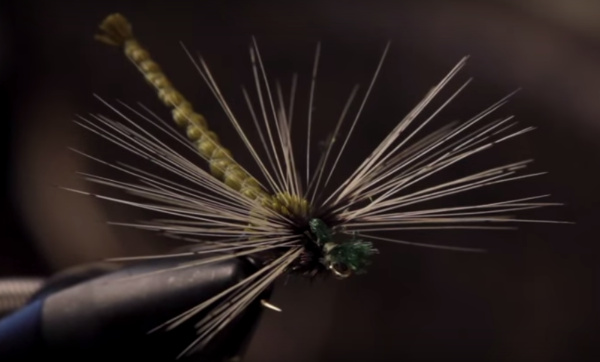Adult dragonflies are an interesting prey species. It’s one of those prey items that many trout anglers think are too big, and bass anglers think are too small. As an angler that targets both fish, I’ve found that both trout and bass will eat dragonflies (and damselflies).
I’ve personally caught both sea-run brook trout and rainbow trout on dragonfly dry fly patterns. I have not caught a brown on a dragonfly, but the video below proves that browns definitely prey on adult dragonflies.
Where to fish Dragonfly Patterns for trout?
For fishing rivers; I’ve found still water, calm eddies, and slow current to work better fishing dragonflies than riffles, tailwaters, or other fast water. I’ve also had better luck with smaller damselfly patterns in rivers than bulky dragonfly patterns. Dragonfly patterns can still work in rivers though. It really depends on the water your fishing and the forage available.
Dragonfly patterns work very well in stillwater such as lakes and ponds. This is probably because there simply tends to be more dragonflies in this environment.
The summer months tend to produce best when fishing dragonfly patterns, but they can be successfully fished as early in the year as May.
How to Fish Dragonfly Patterns for Trout?
In slow current, you can drift the fly like you would any other dry fly. A few twitches can help mimic a struggling dragonfly that got caught in the surface film, but trout will take a dead drift as well.
When fishing stillwater with active trout, you can try “skipping” the fly across the surface. This imitates and dragonfly skimming along the surface either hunting or depositing eggs.
Great success can be found fishing them like a bomber, slapping the fly down like a dragonfly crashing into the water. Fishing this way, you can either let the fly finish its drift, or you can drag the dragonfly back to you very slowly. A real dragonfly has limited swimming capacity, but they can cover water slowly. The trick to this presentation is to get the smallest wake forming behind the fly.
However you fish them, be ready. The strikes are often explosive and exciting, we’re not fishing midges here.
Best Dragonfly Dry Fly Patterns?

Here’s a list of some great dragonfly and damselfly patterns to try for trout.
A comment about wings. I’ve tied and fished a number of different dragonfly patterns. I’ve found that solid plastic wings will cause a significant line twist when casting. I much prefer to use a material that doesn’t catch as much air for the wings. deer hair, or natural feathers cast much more nicely than plastic wings. Even when using these materials, tie them sparse, as they still catch a bit of wind.
I’ve had much more success fishing patterns tied with natural materials than those tied with foam. With dragonfly patterns, leave the foam patterns to warm water anglers. As a side note, that’s not to say foam doesn’t have its place in trout fishing. Foam terrestrial patterns (hoppers mostly) have worked very well for me.
What about Nymphs?
Catching trout on a dry fly dragonfly pattern is an exciting and unique experience in fly fishing. If you really want to catch trout by mimicking dragonflies, dragonfly and damselfly nymph imitations is the way to go. These nymphs vary significantly in size and shape. Some are short and fat, while others are quite long and slender.
Damselfly nymphs are well known to many fly anglers. But not as many anglers use dragonfly nymphs to target trout. In most rivers, you’re probably better off with a damselfly nymph pattern. The best places to use dragonfly nymph patterns are lakes and ponds.
In contrast to their adult form, dragonfly nymphs are a long-lived food source for trout, that are available year-round. Most dragonfly nymphs live for 4-5 years in nymph form.
They tend to huge the shallower areas of lakes and ponds. Dragonfly nymphs are drawn to vegetation but can be found in rocky areas as well. Here’s a good post regarding dragonfly nymphs in still water and how to target trout with them.
The key to fishing dragonfly nymphs is to keep the fly close to the bottom of the lake. This is not an insect that often swims in the water column, preferring instead to hug the bottom.
You can either fish them with a sink tip fly line as a streamer, or as a typical nymph with an indicator. Since I tend to use dragonfly nymphs in slow (or almost completely still) waters, I prefer to use a sink tip to cover water. I do this by slowly bouncing the nymph along the bottom.
